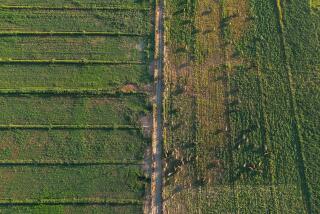State Report Finds Dead Boy’s Backyard Free of Toxics
- Share via
SACRAMENTO — Soil from the backyard of a 4-year-old Riverside boy who died a year ago of a rare blood disease was not contaminated with toxic chemicals as the boy’s family had feared, according to a study completed this month by the state Department of Health Services.
Questions about the methods used in investigating the death of Michael Harman, who died of aplastic anemia last November, triggered what has become a wider FBI probe into how the state handles contracts for cleaning up hazardous waste sites. The boy lived within a mile of the Stringfellow Acid Pits, one of several hazardous waste dump sites managed by the department’s toxic substances control division under the federal Superfund cleanup program.
The latest test results may help to rule out hazardous waste as the cause of the Harman boy’s death, but the FBI investigation into the state’s contracting practices and the possibility of misappropriation of funds is continuing, according to Department of Health Services sources who asked not to be identified.
Soil samples from the yard where the child played contained none of the chemicals that might have caused the fatal disease, according to the company hired by the department to do the detailed chemical studies.
Those results were confirmed by the department’s hazardous materials laboratory.
“We conclude that this child’s yard was not the site of illicit dumping, that the child’s yard contains no chemicals known to cause aplastic anemia at high levels, and that the yard is no different chemically from a typical safe yard in the Riverside area,” said a report released by the department.
The boy’s parents, Steve and Diane Harman, are still not convinced and now plan to show the state report to a toxics expert before accepting the state’s findings. The family moved out of the $120,000 home earlier this year after a private testing laboratory that they hired warned them that there were dangerous levels of toxic chemicals in the soil.
“We do not intend to move back,” Steve Harman said in a telephone interview Monday.
Unable to continue making payments on their Cal-Vet home loan, the Harmans were notified that the Department of Veterans Affairs intended to foreclose. But that action was put on hold until the Department of Health Services completed its testing. Harman said he has been unsuccessful in his efforts to contact Cal-Vet officials about their intentions now that the test results have been released.
The Harman home is not in an area expected to be affected by contamination from Stringfellow. Toxic waste is flowing from the dump site in an underground plume, but in the opposite direction.
However, after the death of the child, the family suspected that there had been illicit dumping of waste in their neighborhood. The Department of Health Services asked Science Applications International Corp., hired to prepare cleanup plans at Stringfellow, to take soil samples. The Harmans contended that a representative of the private firm assured them that their soil was clean. But department officials now admit that the soil was never tested.
The family also accused the state of quashing its own internal investigation into the way the Department of Health Services handled the original soil samples.
The Harman case, along with a critical report on state contracting procedures by the U.S. Environmental Protection Agency, raised the possibility that the department’s toxics division might have been billed for services never performed. FBI agents are now trying to determine whether that has been the case at several federal Superfund sites in California.
More to Read
Sign up for Essential California
The most important California stories and recommendations in your inbox every morning.
You may occasionally receive promotional content from the Los Angeles Times.










